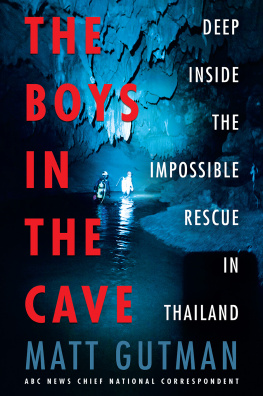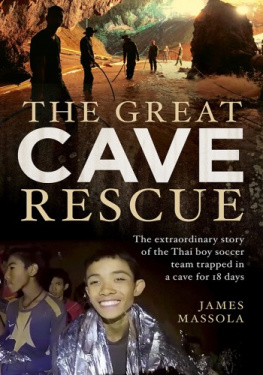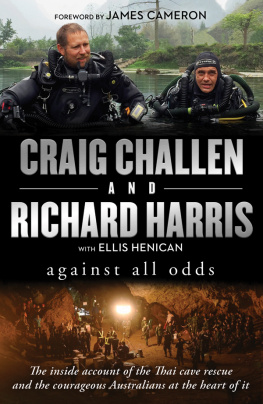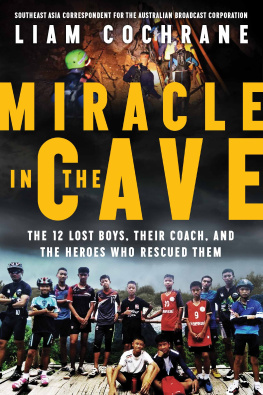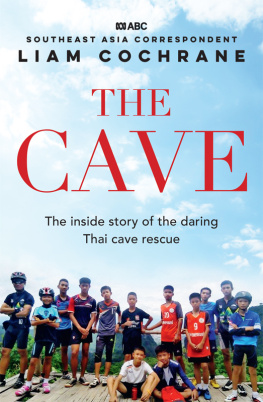Table of Contents
Landmarks
When HarperCollins first pitched me to write this book, it was five days after the rescue had ended. In-depth magazine articles had not yet been written, much less any authoritative history or book. The rescue was so unprecedented that there was as yet no frame of reference for it. That necessitated a near-absolute reliance on first-person accounts and the cooperation of interviewees. The first rescuers at Tham Luang on Saturday, June 23park ranger Petpom and head park ranger Damrongspoke to me a number of times; when the rescue was over they ushered me through the locked gate in front of the mouth of the cave into Chamber One itselfa space grander than I had ever even imagined. They offered me as much time as I wanted and explained every facet of Tham Luang. They even introduced me to the parks new pet Moo Paa wild boar that is actually just a dusky pig. Governor Narongsak also sat for an interview and patiently fielded subsequent calls.
I am indebted to Vern Unsworth, who spent dozens of hours coaching me over the phone, through e-mail, and on the apps WhatsApp and Line on the geology, history, and delights of caves in general and on the object of his particular obsession, Tham Laung. He arguably spent more time at the cave site than any other rescuer; he was extraordinarily generous with his time, painstakingly walking me through the events at the cave multiple times.
Rick Stanton, though reluctant at first, subsequently offered me nearly unfettered access, treating me to the quirks of his character and memorywhich he called quite poor. But he kept tryingreminding me to call him about wonderful little tidbits like his inner tube and cockwomble (see ).
The British Cave Rescue Council and its vice-chair, Bill Whitehouse, offered insight into caving in the UK and key access to its sometimes very private divers and staff. Im also grateful to Chris Jewell and Jason Mallinson, who granted me and ABC News time for interviewsboth while they were in England and while on vacation in Spain. Thanks also to the BCRCs Mike Clayton and to Martin Ellis, for his indispensable maps and Thai caving articles.
The U.S. Air Force offered ABC News (and me in particular) extraordinary access. It opened its doors at Kadena Air Force Base to the network, inviting us to interview officers and NCOs who often spend most of their careers in the shadows. Commanders from Florida to New York to L.A.including Major Craig Savagecontinued to meet with me and answer my unceasing barrage of questions.
Due to the diplomatic and military sensitivities inherent in a project like this, many people spoke to me on the condition of anonymity; my thanks to them. Im also grateful to Colonel Singhanat Losuya and Captain Padcharapon Sukpang, both formerly of the Thai Thirty-seventh Military District. Captain Sukpangs detailed logbook was most useful for a journalist hungry for exact dates, times, and places.
Thanet Natisri also provided many hours of his time. He had taken copious notes himself, and also furnished me with his satellite maps of the mountain, rain fall totals, and a trove of photos. Thanet smoothly shuttled between the worlds of the Thai and foreign rescuers and offered himself as a capable guide to me as wellintroducing me to the many of the people with whom he interacted. Josh Morris, the American owner of Chiang Mai Rock Climbing Adventures, opened up his heart, introducing me to his large teamincluding Austrian Mario Wild and his brother-in-law, Taw, who played a key role from the second day of the rescue onward.
The Euro-divers were also particularly helpful. Mikko Paasi, Claus Rasmussen, Ivan Karadzic, and Ben Reymenants were the first rescue divers to tell me their stories, which in fact became the genesis of this book. They graciously responded to my calls from vacations and at home in Finland, Malta, Belgium, the Philippines, and Phuket. Ruengrit Changwanyuen, who so expertly navigated the no-mans land between the foreign rescuers and the Thai SEALs, kept answering my calls even as he was at work or dropping his kids off at school. He has a remarkable memory and command of details, names, and events.
Additional thanks go to the American expats living in Thailand, including Bruce Konefewho gave me an initial briefing on cave divingthe kind and generous Brandon Fox from Mae Sai, and Biws English teacher Carl Henderson. Thanks also to the U.S. embassy in Thailand, which not only provided information and connections but carefully monitored the safety of its citizens in country.
To the Australians who spoke on and off the record, thank you. And to Australian anesthesiologist Dr. David Wright, thanks for your time as well.
In 2004, Ben Sherwood, who was then the executive producer of Good Morning America, instituted the Oxygen Rule. More guidance than unbending law, it offered assignment editors carte blanch to deploy reporters, producers, and cameras anywhere in the world where people were at risk of expiring from lack of air. The theory is that there is automatic public interest when humans are trapped in a confined space and at risk of running out of air, with other humans desperately trying to save them. The Oxygen Rule was also a nod to the growing technological arsenal at the disposal of TV newswe could now broadcast from phones, the internet, even social mediaenabling reporters to file inexpensively from almost anywhere in the world. After a while the rule became ingrained in ABC News culture. And it partly explains the networks quick deployment and subsequent surge of reporters and staff to the cave site. Sherwood, an author himself, offered early and tremendously useful guidance on quickly getting a project like this started.
Kerry Smith, Senior Vice President, ABC News Editorial, read and commented on every iteration of this writing. Smith possesses twin skills that lend themselves to this process: she is the fastest and most thorough reader I know, and possesses peerless judgment. With her deft touch and decades of experience, she provided thoughtful input throughout. ABCs crack lawyer Maherin Gangat also helped improve the work with each draft she read. I am indebted to ABC News current president, James Goldston, and his leadership team of Barbara Fedida, Wendy Fisher, and David Herndon for dispatching me on what became a remarkable journey to Thailand, and then generously granting me the time to finish this work. Foreign News Manager Kirit Radiat lived and breathed this story. ABC 20/20 s Terri Lichtstein brought to life our three, hour-long documentaries about the rescue.
ABC News sent many people to the rescue, all of whom played key roles. Robert Zepeda and Scott Shulman helped get me on air day after day. Correspondent James Longman generously shared reminiscences of his time in Thailand, including one of my favorite episodes in the bookGoogle Translates misfired rendering of our driver Nops effort to inform ABC News that the rescue had started. It resulted in this garbled gem: never again alpaca. Brandon Baur coordinated ABC News operation in Thailand; even after ABC pulled up stakes, he managed our network of fixers and translators still on the ground. Led by Than Rassanadanukul, they were our eyes and ears in Thailand, and ultimately became our dear friends. Mancharee Sangmueang, who juggled journalism with her pharmacy school exams, spent many hours as my language liaison in Thailand, translating documents and articles and negotiating with Thai officials. Carol Isoux accompanied me when I returned to Mae Sai on my last reporting trip there and helped with multiple interviews. Vishan Chaudhary, with his lightning-fast Google skills, proved a quick and capable research assistant.
The idea for this book was conceived by director of creative development Lisa Sharkey at HarperCollins. The former television news producer reached out to me on Facebook, then assembled a special tactics unit of her own comprised of executive editor Matt Harper and assistant editor Anna Montague. Tremendous thanks must also go to Nyamekye Waliyaya, Andrea Molitor, Mumtaz Mustafa, Leah Carlson-Stanisic, and Maddie Pillari. Sharkey imposed a terrifyingly quick deadline, but made herself available for questions or counsel nearly twenty-four hours a day; she ultimately had a hand in every aspect of the work, from the editing down to the marketing and book placement. Her enthusiasm for this project and her energy kept me going throughout. Sharkeys enthusiasm was matched perhaps only by that of my agents Jay Sures, Albert Lee, and Byrd Leavellwho also served as guides to the uncharted territory of a first book. During the initial month of writing, editor Matt Harper and I likely spoke more frequently and at greater length to one another than to our spouses. Harper threw himself into our shotgun marriage and this project, working nights and weekends even after the birth of his second daughter. It was a dream collaboration with an editor of his intellect and sensitivity.

